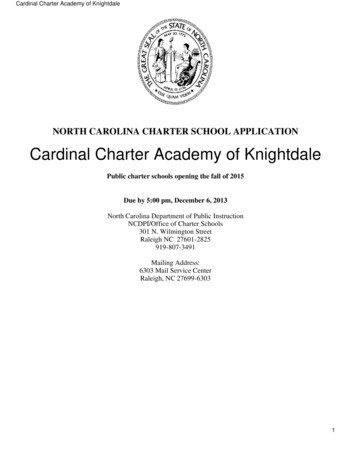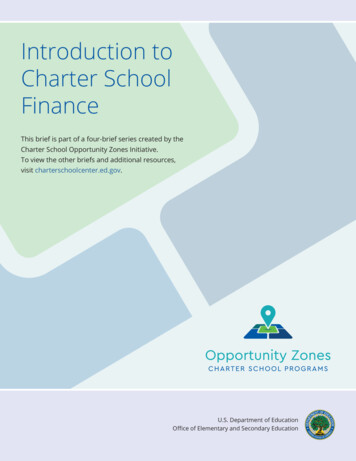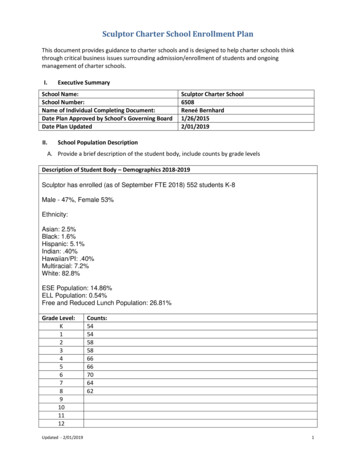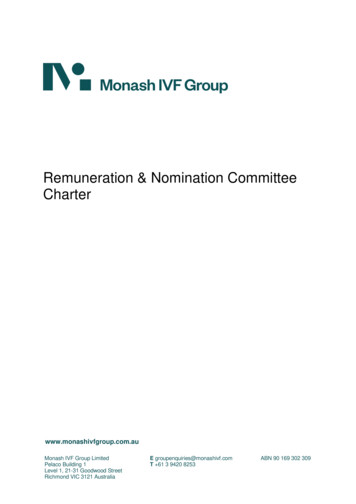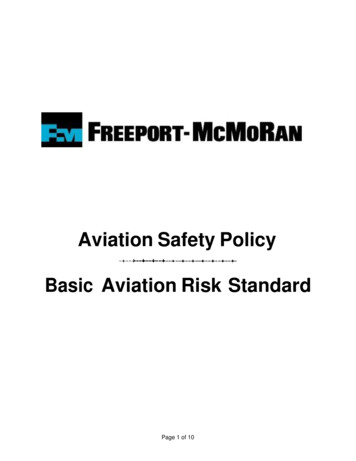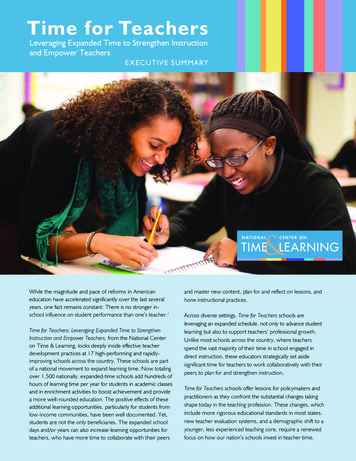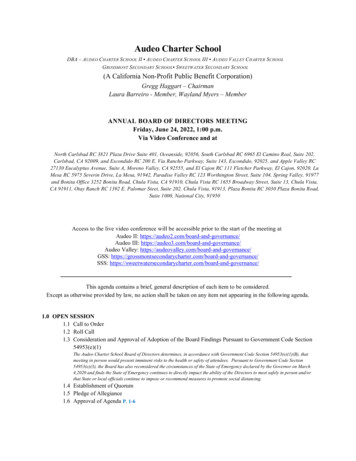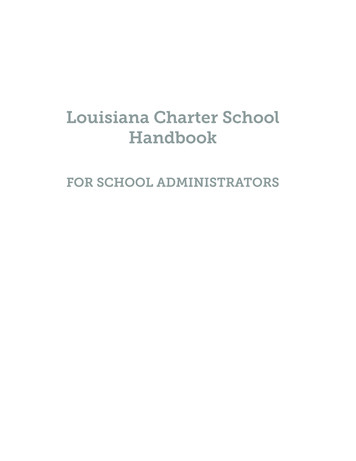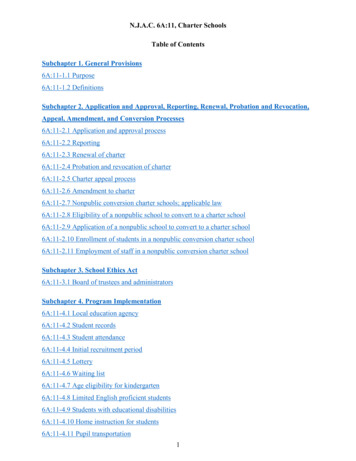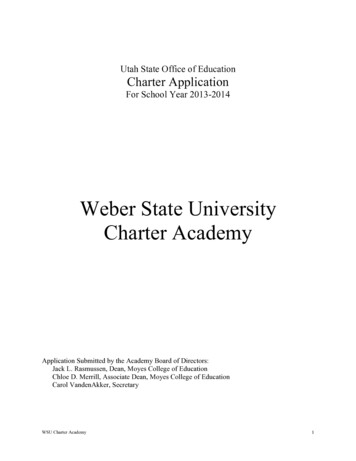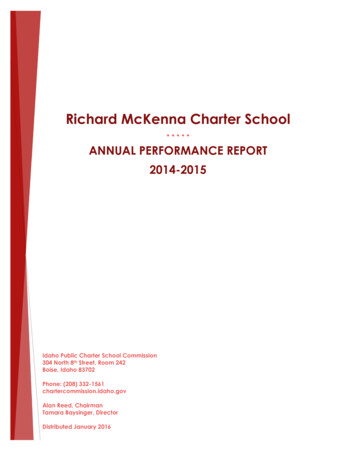
Transcription
Richard McKenna Charter School ANNUAL PERFORMANCE REPORT2014-2015Idaho Public Charter School Commission304 North 8th Street, Room 242Boise, Idaho 83702Phone: (208) 332-1561chartercommission.idaho.govAlan Reed, ChairmanTamara Baysinger, DirectorDistributed January 2016
IntroductionEach year, Idaho’s Public Charter School Commission (PCSC) issues a performance report to everyschool in its portfolio. The annual report serves several purposes:1. To provide transparent, data-driven information about charter school quality;2. To ensure that charter school boards have access to clear expectations and are providedmaximum opportunity to correct any deficiencies prior to their renewal year; and3. To inform mid-term decision making, such as the evaluation of charter amendmentproposals.This report contains an overview of the school, including its history, mission, leadership, anddemographics. The overview is followed by the school’s performance framework, includingoutcomes for the most recently completed school year.The performance framework is comprised of four sections: Academic, Mission-Specific,Operational, and Financial. Each section contains a number of measures intended to evaluatethe school’s performance against specific criteria. The scorecard pages of the framework offer asummary of the school’s scores and accountability designation ranging from Honor (high) toCritical (low).Due to significant and ongoing changes to the state’s school accountability system, many of theacademic measures in the performance framework could not be scored this year. Data for all ofthe growth measures and most of the post-secondary readiness measures was unavailable. As aresult, academic framework scores cannot reflect the intended scope of information.Additionally, although ISAT Math and English Language Arts proficiency data was available, it wasgathered using an assessment that the state adopted subsequent to the framework’sdevelopment. The cut scores used to establish proficiency remain under evaluation, and it cannotbe determined at this time whether or not the rating categories within each framework measureare appropriate in the context of the new assessment.For these reasons, we have eliminated academic framework scores from this report and insteadprovided comparisons of the public charter schools’ proficiency rates to those of the state as awhole, as well as to area schools that serve similar grade ranges. In some cases, comparisonscannot be provided because the data is masked per state law or statistical irrelevance.To facilitate a clearer context for the academic results contained in this report, the demographic,enrollment, and school leadership data provided is from the 2014-15 school year. Updatedenrollment and school leadership information is available upon request from the school or PCSCoffice.Schools had an opportunity to correct or clarify their framework outcomes prior to the publicationof this report.Public charter school operations are inherently complex. For this reason, readers are encouragedto consider the scores on individual measures within the framework as a starting point for gainingfull, contextualized understanding of the school’s performance.Additional information about how the performance framework was developed and how resultsmay be interpreted is available on the PCSC’s website: chartercommission.idaho.gov.
School OverviewMission StatementKey DesignElementsSchool ContactInformationSurrounding DistrictOpening YearCurrent TermGrades ServedEnrollmentThe mission of Richard McKenna Charter High School is to preparestudents for successful post-secondary education, training, andemployment. We focus on developing strong reading, writing, math,and study skills in the context of a liberal arts education. Active Learning. We teach our students how to formulatequestions, develop solutions, apply solutions, and share the resultsby focusing on:o Critical and Analytical Thinkingo Hard Work, Respect, and Serviceo Presentations and Projectso Reflecting and Recording Focused Learning. We use a block schedule that allows students tofocus on a few courses at a time in great depth. Online Learning. We provide online courses for both general ed.and at-risk students statewide. Online learning providesconvenience and flexibility for students who cannot attend class ina traditional setting.Address: 675 South Haskett Street,Mountain Home, ID 83647Phone: 208-580-2449Mountain Home School District2002June 17, 2014 – June 30, 20179 - 12Approved: 75 on site, unlimitedonlineActual: 232
School Leadership (2014-2015)RoleMeg WarrenChairDon DowVice ChairMelody LandisDirectorDoug MayneTreasurerMaralee SmithDirectorLarry n-White23.95%32.70%23.59%Limited EnglishProficiency0%7.85%8.52%Special Needs1.80%11.70%10.43%Free & Reduced Lunch39.52%46.91%49.62%GEN ResultALT ResultNoneNone****28.9%10.6%Academic MeasureState Accountability Designation (if applicable)Percentage of Students Meeting or ExceedingProficiencyin MathPercentage of Students Meeting or ExceedingProficiencyin English Language ArtsGraduation Rate (4-year cohort data from 2014)*masked per state law or statistical irrelevance
PUBLIC CHARTER SCHOOL COMMISSION - PERFORMANCE FRAMEWORKName of School: Richard McKenna Charter High SchoolYear Opened: 2002Operating Term: 6/17/14-6/30/17Date Executed: 6/17/2014IntroductionIdaho’s charter school legislation requires each public charter school authorizer to develop a Performance Framework on which the provisions of the PerformanceCertificate will be based. Performance Frameworks must clearly set forth the academic and operational performance indicators, measures, and metrics that will guidethe authorizer’s evaluations of each public charter school, and must contain the following: Indicators, measures, and metrics for student academic proficiency; Indicators, measures, and metrics for student academic growth; Indicators, measures, and metrics for college and career readiness (for high schools); and Indicators, measures, and metrics for board performance and stewardship, including compliance with all applicable laws, regulations and terms of theperformance certificate.The measurable performance targets contained within the framework must require, at a minimum, that each school meet applicable federal, state, and authorizer goalsfor student achievement. This Performance Framework was adopted by the Public Charter School Commission (PCSC) on August 30, 2013, and is intended for use withnon-alternative public charter schools authorized by the PCSC.Performance Framework StructureThe Performance Framework is divided into four sections: Academic, Mission-Specific, Operational, and Financial. The Academic and Mission-Specific sections comprisethe primary indicators on which most renewal or non-renewal decisions will be based. The Operational and Financial sections contribute additional indicators that will,except in cases of egregious failure to meet standards, be considered secondary.Academic:A high percentage (60%) of a school’s total score for the Academic & Mission Specific Accountability Designation reflects the school’s performance on a set ofacademic measures. These measures are the same for all non-alternative schools. The “Meets Standard” rating for each measure is designed to align closelywith state minimum standards as established in Idaho’s ESEA waiver and Star Rating System.Mission-Specific:A significant portion (40%) of a school’s total score for the Academic & Mission Specific Accountability Designation reflects the school’s performance on a setof mission-specific measures. These measures may be academic or non-academic in nature, but must be objective and data-driven. The number andweighting of mission-specific measures should be established during one-on-one negotiations between the school and authorizer.During their first Performance Certificate term only, schools authorized to open in or before Fall 2014 may choose to opt out of the Mission-Specific section of theframework. Schools choosing to opt out of Mission-Specific measures for their first term agree that the weight of those measures will be placed instead on theAcademic section, which then becomes the single, primary factor considered for purposes of renewal or non-renewal.Operational:Operational indicators comprise a secondary element for consideration during the renewal process. While each school will receive a score in the operationalsection, this score should not be used as the primary rationale for non-renewal unless the non-compliance with organizational expectations is severe orsystemic. Particularly for a school whose academic performance meets or exceeds standards, poor results in this area are more likely to lead to a conditionalrenewal decision than to non-renewal.
Financial:Financial indicators comprise a secondary element for consideration during the renewal process. While each school will receive a score in the financialsection, this score should not be used as the primary rationale for non-renewal unless the school’s financial state at the time of renewal is dire. Particularly fora school whose academic performance meets or exceeds standards, poor results in this area are more likely to lead to a conditional renewal decision than tonon-renewal. The PCSC may also elect to renew a financially troubled school that is clearly providing a high quality education, but notify the SDE of thesituation so that the payment schedule may be modified in order to safeguard taxpayer dollars.Accountability DesignationsCalculation of the percentage of eligible points earned for each school will guide the determination of that school’s accountability designation: Honor, Good Standing,Remediation, or Critical. The accountability designation will, in turn, guide the PCSC’s renewal or non-renewal decision-making. Measures for which a school lacks datadue to factors such as grade configuration or small size will not contribute to that school’s accountability designation. The PCSC will consider contextual factors affectinga school’s accountability designation when making renewal or non-renewal decisions.Honor:Schools achieving at this level in all categories (academic, mission-specific, operational, and financial) are eligible for special recognition and will berecommended for renewal. Replication and expansion proposals are likely to succeed. The Framework places schools that earn 75-100% of the combinedacademic and mission-specific points possible in this accountability designation. It is possible for 5-star schools, high-range 4-star schools with solid missionspecific outcomes, and mid-range 4-star schools with strong mission-specific outcomes to receive an honor designation. Schools that fall into this pointpercentage category but have poor operational and/or financial outcomes will not be eligible for an honor designation.Good Standing:Schools achieving at this level will be recommended for renewal; however, conditional renewal may be recommended if operational and/or financialoutcomes are poor. Replication and expansion proposals will be considered. To be placed in this category, schools much receive the appropriate percentageof the combined academic and mission-specific points possible and have at least a 3-star rating. The Framework places schools that earn 55-74% of thecombined academic and mission-specific points possible in this accountability designation. It is possible for 3-star or 4-star schools with solid mission-specificoutcomes, or 5-star schools with poor mission-specific, financial, and/or operational outcomes to receive a good standing designation. Although 2-star schoolswith strong mission-specific outcomes could fall into this point-percentage range, they would not be eligible to receive a good standing designation due totheir star ratings; the Framework is drafted thus in recognition of Idaho’s statutory provision that the performance framework shall, at a minimum, requirethat each school meet applicable federal and state goals for student achievement.Remediation:Schools achieving at this level may be recommended for non-renewal or conditional renewal, particularly if operational and/or financial outcomes are poor.Replication and expansion proposals are unlikely to succeed. The Framework places schools that earn 31-54% of the combined academic and mission-specificpoints possible in this accountability designation. It is possible for 3-star schools with poor mission-specific outcomes, 2-star schools, or 1-star schools withstrong mission-specific outcomes to receive a remediation designation.Critical:Schools achieving at this level face a strong likelihood of non-renewal, particularly if operational and/or financial outcomes are also poor. Replication andexpansion proposals should not be considered. The Framework places schools that earn less than 30% of the combined academic and mission-specific pointspossible in this accountability designation. It is possible for 1-star schools or 2-star schools with poor mission-specific outcomes to receive a Criticaldesignation.
RMCHS --- PERFORMANCE FRAMEWORK SCORINGACADEMICMeasureState/Federal Accountability1a1b2a2b2c3a3b3c3d3e3f3g4a4b1 / 4b24cProficiencyGrowthCollege & Career ReadinessPossible Elem /MS Points% of Total PointsPOINTS EARNEDDue to significant and ongoing changes in the state's school accountabilitysystem, results for the academic section of this framework are notincluded in this 2015 Annual Report. Please see the School Overview foracademic comparison data.Total Possible Academic Points- Points from Non-ApplicableTotal Possible Academic Points for This SchoolPossible HS Points % of Total 0%7%0%20%20%0%0%0%0%0%0%0%0%0%13%60%Total Academic Points Received% of Possible Academic Points for This SchoolMISSION-SPECIFICPOINTS 0.000.000.000.000.000.00%MeasurePossible Points% of Total PointsPOINTS EARNED1234Reading skills improvementEnglish language skills improvementMath skills improvementStudy skills acquisitionTotal Possible Mission-Specific PointsPossible Points% of Total PointsPOINTS l Mission-Specific Points Received% of Possible Mission-Specific Points Received0.000.00%TOTAL POSSIBLE ACADEMIC & MISSION-SPECIFIC POINTS375TOTAL POINTS RECEIVED% OF POSSIBLE ACADEMIC & MISSION-SPECIFIC POINTSALTERNATIVE PROGRAM ACADEMICMeasureState/Federal Accountability1a1b2a2b2c3a3b3c3d3e3f3g4a4b5a5b1 / 5b25c1 / 5c2ProficiencyGrowthAlternative School Student EngagementCollege & Career ReadinessPossible Elem /MS Points% of Total PointsPOINTS EARNEDDue to significant and ongoing changes in the state's school accountabilitysystem, results for the alternative academic section of this framework are notincluded in this 2015 Annual Report. Please see the School Overview foracademic comparison data.Total Possible Academic Points- Points from Non-ApplicableTotal Possible Academic Points for This SchoolPossible HS Points % of Total al Academic Points Received% of Possible Academic Points for This SchoolALTERNATIVE PROGRAM MISSION-SPECIFICReading skills improvementEnglish language skills improvementMath skills improvementStudy skills acquisitionPOINTS 0.000.000.000.000.000.000.000.00%MeasurePossible Points1234Total Possible Mission-Specific Points% of Total PointsPOINTS EARNEDPossible Points% of Total PointsPOINTS l Mission-Specific Points Received% of Possible Mission-Specific Points ReceivedTOTAL POSSIBLE ACADEMIC & MISSION-SPECIFIC POINTSTOTAL ALTERNATIVE PROGRAM POINTS RECEIVED% OF POSSIBLE ALTERNATIVE ACADEMIC & MISSION-SPECIFIC POINTS0.000.00%3740.000.00%
RMCHS --- PERFORMANCE FRAMEWORK SCORINGOPERATIONALEducational ProgramFinancial Management & OversightGovernance & ReportingStudents & EmployeesSchool EnvironmentAdditional ObligationsMeasurePoints Possible% of Total PointsPoints 025.0025.0015.0025.0025.0025.00400100%TOTAL OPERATIONAL POINTS% OF POSSIBLE OPERATIONAL POINTSFINANCIALNear-Term MeasuresSustainability MeasuresMeasurePoints Possible% of Total PointsPoints 00400100%TOTAL FINANCIAL POINTS% OF POSSIBLE FINANCIAL POINTSACCOUNTABILITY DESIGNATIONGENERAL PROGRAMACADEMIC & MISSION-SPECIFIC% of PointsPossible EarnedHonorSchools achieving at this level in all categories areeligible for special recognition and will be75% - 100%recommended for renewal. Replication andof points possibleexpansion proposals are likely to succeed.Good StandingSchools achieving at this level in Academic &Mission-Specific will be recommended forrenewal; however, conditional renewal may berecommended if Operational and/or Financialoutcomes are poor. Replication and expansionproposals will be considered. To be placed in this55% - 74%category for Academic & Mission-Specific, schoolsof points possiblemust receive the appropriate percentage ofpoints and have at least a Three Star Rating.CriticalSchools achieving at this level in Academic &Mission-Specific face a strong likelihood of nonrenewal, particularly if Operational and/orFinancial outcomes are also poor. Replicationand expansion proposals should not beconsidered.The financial measures included here are based on industry standards. Theyare not intended to reflect the nuances of a school's financial status. A lowscore on any single measure indicates only the possibility of a problem. Inmany cases, contextual information that alleviates concern is provided in thenotes that accompany individual measures. Please see the financial section ofthis framework for additional detail.400.00100.00%RangeRemediationSchools achieving at this level in Academic &Mission-Specific may be recommended for nonrenewal or conditional renewal, particularly ifOperational and/or Financial outcomes are alsopoor. Replication and expansion proposals areunlikely to succeed.355.0088.75%ALTERNATIVE PROGRAMACADEMIC & MISSION-SPECIFICRange% of PointsPossible Earned75% - 100%of points possibleDue to statewidechanges to theschoolaccountabilitysystem, noAcademic &Mission-Specificdesignation isincluded in thisreport.55% - 74%of points possibleOPERATIONALRange% of PointsPossible Earned90% - 100%of points possibleDue to statewidechanges to theschoolaccountabilitysystem, no Alt.Academic &Mission-Specificdesignation isincluded in thisreport.80% - 89%of points possible88.75%FINANCIALRange% of PointsPossible Earned85% - 100%of points possible100.00%65% - 84%of points possible31% - 54%of points possible31% - 54%of points possible61% - 79%of points possible46% - 64%of points possible0% - 30%of points possible0% - 30%of points possible0% - 60%of points possible0% - 45%of points possible
RMCHS --- ACADEMIC FRAMEWORK (2014-2015 data)INDICATOR 1: STATE AND FEDERAL ACCOUNTABILITYMeasure 1aOverall Star RatingResult (Stars)Points Possible5432125201500Points EarnedIs the school meeting acceptable standards according to existing state grading or rating systems?Exceeds Standard: School received five stars on the Star Rating SystemMeets Standard: School received three or four stars on the Star Rating SystemDoes Not Meet Standard: School received two stars on the Star Rating SystemFalls Far Below Standard: School received one star on the Star Rating System0NotesMeasure 1bState DesignationsIs the school meeting state designation expectations as set forth by state and federal accountability systems?Exceeds Standard: School was identified as a "Reward" school.Meets Standard: School does not have a designation.Does Not Meet Standard: School was identified as a "Focus" school.Falls Far Below Standard: School was identified as a "Priority" school.ResultPoints PossibleRewardNoneFocusPriority251500Points Earned0NotesINDICATOR 2: STUDENT ACADEMIC PROFICIENCYMeasure 2aISAT / SBA % ProficiencyReadingAre students achieving reading proficiency on state examinations?Result(Percentage)Exceeds Standard: 90% or more of students met or exceeded proficiency.Meets Standard: Between 65-89% of students met or exceeded proficiency.Does Not Meet Standard: Between 41-64% of students met or exceeded proficiency.Falls Far Below Standard: Fewer than 41% of students met or exceeded proficiency.Points PossiblePossible in thisRangePercentile TargetsPercentile PointsPoints -401125244000000Points PossiblePossible in thisRangePercentile TargetsPercentile PointsPoints -401125244000000NotesMeasure 2bISAT / SBA % ProficiencyMathNotesAre students achieving math proficiency on state examinations?Exceeds Standard: 90% or more of students met or exceeded proficiency.Meets Standard: Between 65-89% of students met or exceeded proficiency.Does Not Meet Standard: Between 41-64% of students met or exceeded proficiency.Falls Far Below Standard: Fewer than 41% of students met or exceeded proficiency.Result(Percentage)
RMCHS --- ACADEMIC FRAMEWORK (2014-2015 data)Measure 2cISAT / SBA % ProficiencyLanguage ArtsAre students achieving language proficiency on state examinations?Result(Percentage)Exceeds Standard: 90% or more of students met or exceeded proficiency.Meets Standard: Between 65-89% of students met or exceeded proficiency.Does Not Meet Standard: Between 41-64% of students met or exceeded proficiency.Falls Far Below Standard: Fewer than 41% of students met or exceeded proficiency.Points PossiblePossible in thisRangePercentile TargetsPercentile PointsPoints -401125244000000Points PossiblePossible in thisRangePercentile TargetsPercentile PointsPoints 1-491615204900000Percentile PointsPoints EarnedNotesINDICATOR 3: STUDENT ACADEMIC GROWTHMeasure 3aCriterion-ReferencedGrowth in ReadingAre students making adequate annual academic growth to achieve proficiency in reading with 3 years or by10th grade?Result(Percentage)Exceeds Standard: At least 85% of students are making adequate academic growth.Meets Standard: Between 70-84% of students are making adequate academic growth.Does Not Meet Standard: Between 50-69% of students are making adequate academic growth.Falls Far Below Standard: Fewer than 50% of students are making adequate academic growth.NotesMeasure 3bCriterion-ReferencedGrowth in MathAre students making adequate annual academic growth to achieve math proficiency within 3 years or by 10thgrade?Result(Percentage)Exceeds Standard: At least 85% of students are making adequate academic growth.Meets Standard: Between 70-84% of students are making adequate academic growth.Does Not Meet Standard: Between 50-69% of students are making adequate academic growth.Falls Far Below Standard: Fewer than 50% of students are making adequate academic growth.Points PossiblePoints possible inPercentile Targetsthis -491615204900000Points PossiblePossible in thisRangePercentile TargetsPercentile PointsPoints 1-491615204900000NotesMeasure 3cCriterion-ReferencedGrowth in LanguageNotesAre students making adequate annual academic growth to achieve language proficiency within 3 years or by10th grade?Exceeds Standard: At least 85% of students are making adequate academic growth.Meets Standard: Between 70-84% of students are making adequate academic growth.Does Not Meet Standard: Between 50-69% of students are making adequate academic growth.Falls Far Below Standard: Fewer than 50% of students are making adequate academic growth.Result(Percentage)
RMCHS --- ACADEMIC FRAMEWORK (2014-2015 data)Measure 3dNorm-ReferencedGrowth in ReadingPoints PossiblePossible in thisRangePercentile TargetsPercentile PointsPoints 293423132900000Points PossiblePossible in thisRangePercentile TargetsPercentile PointsPoints 293423132900000Points PossiblePossible in thisRangePercentile TargetsPercentile PointsPoints Earned57-751966-99340Meets Standard: The school's Median SGP in language arts falls between the 43 and and 65 percentile.38-561943-65230Does Not Meet Standard: The school's Median SGP in language arts falls between the 30th and 42th percentile.20-371830-421300-19191-292900Points PossiblePossible in thisRangePercentile TargetsPercentile PointsPoints 1-293125152900000Are students making expected annual academic growth in reading compared to their academic peers?Result (Percentile)Exceeds Standard: The school's Median SGP in reading falls between the 66th and 99th percentile.Meets Standard: The school's Median SGP in reading falls between the 43rd and and 65th percentile.Does Not Meet Standard: The school's Median SGP in reading falls between the 30th and 42th percentile.Falls Far Below Standard: The school's Median SGP in reading falls below the 30th percentile.NotesMeasure 3eNorm-ReferencedGrowth in MathAre students making expected annual academic growth in math compared to their academic peers?Result (Percentile)Exceeds Standard: The school's Median SGP in math falls between the 66th and 99th percentile.Meets Standard: The school's Median SGP in math falls between the 43rd and and 65th percentile.Does Not Meet Standard: The school's Median SGP in math falls between the 30th and 42th percentile.Falls Far Below Standard: The school's Median SGP in math falls below the 30th percentile.NotesMeasure 3fNorm-ReferencedGrowth in LanguageAre students making expected annual academic growth in language compared to their academic peers?Result (Percentile)Exceeds Standard: The school's Median SGP in language arts falls between the 66th and 99th percentile.rdththFalls Far Below Standard: The school's Median SGP in language arts falls below the 30 percentile.NotesMeasure 3gSubgroup GrowthCombined SubjectsNotesIs the school increasing subgroup academic performance over time?Exceeds Standard: School earned at least 70% of possible points in SRS Accountability Area 3.Meets Standard: School earned 45-69% of possible points in SRS Accountability Area 3.Does Not Meet Standard: School earned 30-44% of possible points in SRS Accountability Area 3.Falls Far Below Standard: School earned fewer than 30% of possible points in SRS Accountability Area 3.Result(Percentage)
RMCHS --- ACADEMIC FRAMEWORK (2014-2015 data)INDICATOR 4: COLLEGE AND CAREER READINESSMeasure 4aAdvanced OpportunityAre students participating successfully in advance opportunity coursework?CourseworkExceeds Standard: School earned 5 points in SRS Post-Secondary Content Area: Advanced OpportunityMeets Standard: School earned 3-4 points in SRS Post-Secondary Content Area: Advanced OpportunityDoes Not Meet Standard: School earned 2 points in SRS Post-Secondary Content Area: Advanced OpportunityFalls Far Below Standard: School earned 1 or fewer points in SRS Post-Secondary Content Area: Adv OpptyResultPoints Possible5503-42301010Points EarnedNotesMeasure 4b1College EntranceExam Results0Does students' performance on college entrance exams reflect college readiness?Exceeds Standard: Effective in 2013-14, at least 35% of students met or exceeded the college readinessbenchmark on an entrance or placement exam.Meets Standard: Effective in 2013-14, between 25-34% of students met or exceeded the college readinessbenchmark on an entrance or placement exam.)Does Not Meet Standard: Effective in 2013-14, between 20-24% of students met or exceeded the collegereadiness benchmark on an entrance or placement exam.)Falls Far Below Standard: Effective in 2013-14, fewer than 20% of students met or exceeded the collegereadiness benchmark on an entrance or placement exam.ResultPoints Possible5503-43021010Points Earned0NotesMeasure 4b2College EntranceExam ResultsDoes students' performance on college entrance exams reflect college readiness?Exceeds Standard: Effective in 2014-15 and thereafter, at least 45% of students met or exceeded the collegereadiness benchmark on an entrance or placement exam.Meets Standard: Effective in 2014-15 and thereafter, between 35-44% of students met or exceeded the collegereadiness benchmark on an entrance or placement exam.Does Not Meet Standard: Effective in 2014-15 and thereafter, between 30-34% of students met or exceeded thecollege readiness benchmark on an entrance or placement exam.Falls Far Below Standard: Effective in 2014-15 and thereafter, fewer than 30% of students met or exceeded thecollege readiness benchmark on an entrance or placement exam.ResultPoints Possible5503-43021010Points Earned0NotesMeasure 4cGraduation RateAre students graduating from high school?Exceeds Standard: At least 90% of students graduated from high school.Meets Standard: 81-89% of students graduated from high school.Does Not Meet Standard: 71%-80% of students graduated from high school.Falls Far Below Standard: Fewer than 70% of students graduated from high school.NotesResult(Percentage)Possible OverallPossible in thisRangePercentile TargetsPercentile PointsPoints -70119107000000
RMCHS GEN --- MISSION-SPECIFIC FRAMEWORKMISSION-SPECIFIC GOALSMeasure 1Is the school helping students gain appropriate reading skills?Exceeds Standard: 86%-100% of students who had an attendance rate of 90% or higher since thebeginning of the school year increased their reading by at least one grade level equivalent as measuredby the Test of Adult Basic
Idaho Public Charter School Commission 304 North 8th Street, Room 242 Boise, Idaho 83702 Phone: (208) 332-1561 chartercommission.idaho.gov . The mission of Richard McKenna Charter High School is to prepa re students for successful post-secondary education, training, and employment. We focus on developing strong reading, writing, math,
